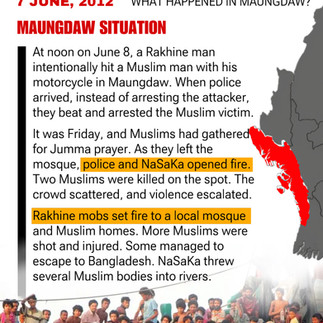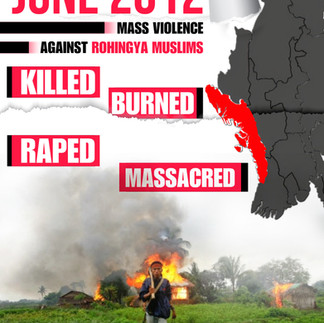
June 2012 Mass Violence in Arakan: A Timeline of Brutality Against Rohingya Muslims
- Arakan Now

- Jun 3
- 3 min read
Arakan Now - 3rd June 2025
Kyauk Ni Maw (Thandwe) Incident
A Rakhine Buddhist girl was found murdered near a Muslim village in Kyauk Ni Maw, Thandwe Township. Local authorities accused her former Muslim boyfriend and two of his friends of raping and killing her. But the medical report confirmed she was not raped.
Despite this, Rakhine extremists began spreading false information and distributing hate-filled pamphlets to stir anger against Muslims.
See here:
Taungup Massacre – June 3, 2012
A group of Muslim pilgrims traveling by bus was brutally attacked by Rakhine extremists in Taungup Township. The attackers beat them to death, targeting their heads until their skulls were crushed and brains spilled out. The victims were then slaughtered. All ten Muslims on the bus were killed.
See here:
Myebon, Kyaukphyu, and Kyauktaw Massacres
In Myebon, Kyaukphyu, and Kyauktaw townships, mass violence broke out. Rakhine mobs, taking advantage of their larger numbers, attacked Muslim communities. Reports say more than 4,000 Muslims were killed.
Around 2,500 of them were children and newborns. Newborn babies were reportedly impaled on steel rods and thrown into fire. Many Muslim homes were burned down. The same horrific patterns were seen across these areas.
See here:
Sittwe Massacres – Starting June 7, 2012
The violence spread to Sittwe, starting with the burning of Zalla Fara, a Muslim village. All villagers there were killed. The attacks continued to other Muslim areas including Nazir Fara, Amala Fara, Hausha Fara, San Taw Laik, Bomu Rwar, and Bo Pwa Fara.
These attacks were not carried out by civilians alone. Rakhine mobs joined hands with state security forces: police, NaSaKa (Border Security Forces), Lone Htein (riot police), and military troops. Rakhine attackers used knives and homemade guns. Government forces used military-grade firearms.
Muslim families were locked inside homes and burned alive. Children and babies were thrown into rivers or fires. Some children were tied up and set on fire.
Thousands of survivors were pushed into displacement camps. Many fled by boat to Bangladesh. But five boats carrying Muslim refugees were turned back by Bangladeshi authorities. NaSaKa shot and sank three boats at sea. Two others faced tragedy—pregnant women died giving birth on board. Survivors who made it back to shore were shot dead by Burmese security forces.
See here:
Maungdaw Situation – June 8, 2012
At noon on June 8, a Rakhine man intentionally hit a Muslim man with his motorcycle in Maungdaw. When police arrived, instead of arresting the attacker, they beat and arrested the Muslim victim.
It was Friday, and Muslims had gathered for Jumma prayer. As they left the mosque, police and NaSaKa opened fire. Two Muslims were killed on the spot. The crowd scattered, and violence escalated.
Rakhine mobs set fire to a local mosque and Muslim homes. More Muslims were shot and injured. Some managed to escape to Bangladesh. NaSaKa threw several Muslim bodies into rivers.
See here:
Buthidaung Situation
In Buthidaung, where Rakhines are a minority, no major clashes occurred in June. But the military (Sa Ka Kha group 15 and Strategy Group 18) and local police still carried out targeted arrests.
Police were ordered to arrest educated Muslims from every village. Some were held for two days, then sent to jail. Many were tortured—some to death. Rich and known Muslims were extorted. If families couldn’t pay, detainees were tortured.
Rakhine monks in Buthidaung organized secret meetings, planning to import weapons from Sittwe. On November 3, 2012, the military seized 180 handmade guns from Rakhine groups in Buthidaung.
The local government provided support to the Rakhine extremists and encouraged attacks. All local police were Rakhine and were openly violent toward Muslims.
See here:
Conclusion
The violence that began on June 3, 2012, turned into widespread, coordinated attacks against Rohingya Muslims across Rakhine State. It involved local mobs, security forces, and government complicity. Thousands were killed, entire communities were destroyed, and tens of thousands were forced into camps or into exile. The scars of this brutality continue to shape the Rohingya struggle for justice and survival.
See here:
























